 The 2010 Maryhill Rose’ of Sangiovese is sourced from the Tudor Hills Vineyard in the Yakima Valley AVA inside the Columbia Valley AVA in Washington. In Tuscany, Sangiovese is the grape used to create Chianti, to be called a Chianti, the wine must contain a minimum of 80% Sangiovese grapes. To describe it in simple terms, a Rose’ is Red wine grapes turned into wine using White wine methods. The color of the wine comes from the grape skins, with a Rose’ the Red grape skins are removed shortly after the grapes are crushed, allowing the skins to only impart a lighter, pinker color. Since Rose’ typically does not see any oak aging and is light in tannins (tannins come from the grape skins, so pull the skins out early equals less tannins), flavors that are masked or dominated by the full bodied flavors and oak of a regular Red wine, have a chance to shine. The Maryhill Rose was fermented and aged in stainless steel tanks and the alcohol content is 12.7%.
The 2010 Maryhill Rose’ of Sangiovese is sourced from the Tudor Hills Vineyard in the Yakima Valley AVA inside the Columbia Valley AVA in Washington. In Tuscany, Sangiovese is the grape used to create Chianti, to be called a Chianti, the wine must contain a minimum of 80% Sangiovese grapes. To describe it in simple terms, a Rose’ is Red wine grapes turned into wine using White wine methods. The color of the wine comes from the grape skins, with a Rose’ the Red grape skins are removed shortly after the grapes are crushed, allowing the skins to only impart a lighter, pinker color. Since Rose’ typically does not see any oak aging and is light in tannins (tannins come from the grape skins, so pull the skins out early equals less tannins), flavors that are masked or dominated by the full bodied flavors and oak of a regular Red wine, have a chance to shine. The Maryhill Rose was fermented and aged in stainless steel tanks and the alcohol content is 12.7%.
The color is a shiny, glistening salmon pink. The nose is a mix of white wine and red wine aromas, grapefruit, watermelon, pineapple, sweet cherry and a light floral edge. This is a dry Rose’, no sweet wine here. It starts with light creamy strawberries, follow by tart, slightly sour cherry. The mid palate introduces an interesting astringent texture, along with pink grapefruit and Anjou pear. The acidity shows up on the finish, it is balanced, but it has you smacking your lips as the finish lingers on.
The Maryhill Rose’ of Sangiovese is a classy, sophisticated $10 Rose’. There is an interesting mix of flavors and textures in a bone dry wine, it reminds me more of a Rose’ from Anjou in the Loire Valley (they really rock, you should try one) than something from the country that invented White Zinfandel. The Maryhill Rose’ would make a lovely wine to enjoy on the patio while watching the sun go down.
